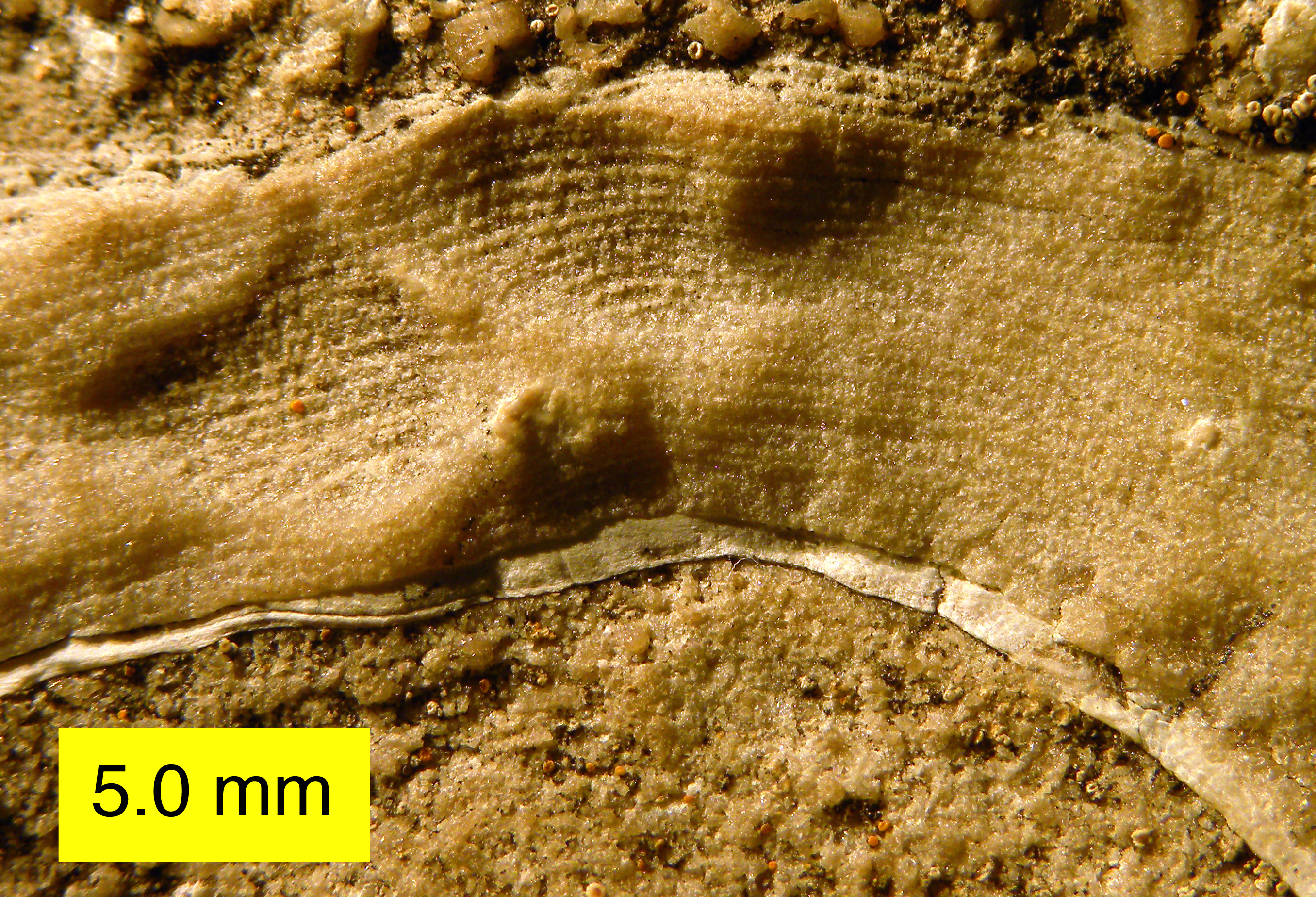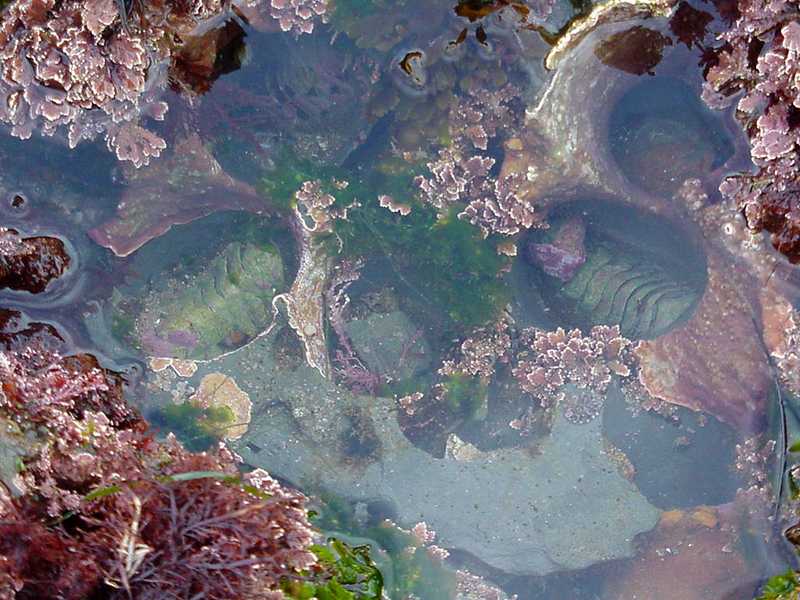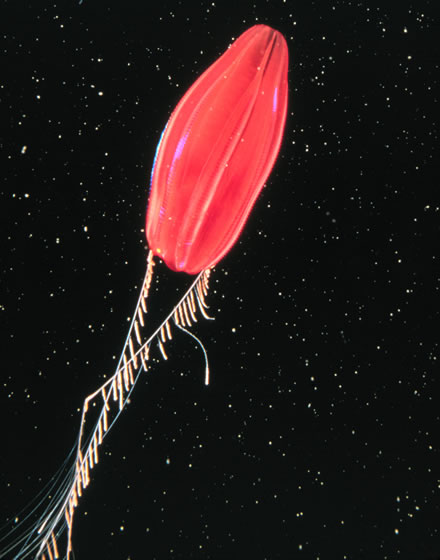|
Goniatite
Goniatids, informally goniatites, are ammonoid cephalopods that form the order Goniatitida, derived from the more primitive Agoniatitida during the Middle Devonian some 390 million years ago (around Eifelian stage). Goniatites (goniatitids) survived the Late Devonian extinction to flourish during the Carboniferous and Permian only to become extinct at the end of the Permian some 139 million years later. Morphology All goniatites possessed an external shell, which is divided internally into chambers filled with gas giving it buoyancy during the life of the animal. An open chamber at the front of the shell provided living space for the goniatitid animal, with access to open water through a ventral siphuncle. The general morphology and habit of goniatites was probably similar to that of their later relatives the ammonites, being free swimming and possessing a head with two well developed eyes and arms (or tentacles). Goniatite shells are small to medium in size, almost alway ... [...More Info...] [...Related Items...] OR: [Wikipedia] [Google] [Baidu] |
Ammonoidea
Ammonoids are extinct, (typically) coiled-shelled cephalopods comprising the subclass Ammonoidea. They are more closely related to living octopuses, squid, and cuttlefish (which comprise the clade Coleoidea) than they are to nautiluses (family Nautilidae). The earliest ammonoids appeared during the Emsian stage of the Early Devonian (410.62 million years ago), with the last species vanishing during or soon after the Cretaceous–Paleogene extinction event (66 million years ago). They are often called ammonites, which is most frequently used for members of the order Ammonitida, the only remaining group of ammonoids from the Jurassic up until their extinction. Ammonoids exhibited considerable diversity over their evolutionary history, with over 10,000 species having been described. Ammonoids are excellent index fossils, and they have been frequently used to link rock layers in which a particular species or genus is found to specific Geologic time scale, geologic time periods. Their ... [...More Info...] [...Related Items...] OR: [Wikipedia] [Google] [Baidu] |
Fossil
A fossil (from Classical Latin , ) is any preserved remains, impression, or trace of any once-living thing from a past geological age. Examples include bones, shells, exoskeletons, stone imprints of animals or microbes, objects preserved in amber, hair, petrified wood and DNA remnants. The totality of fossils is known as the ''fossil record''. Though the fossil record is incomplete, numerous studies have demonstrated that there is enough information available to give a good understanding of the pattern of diversification of life on Earth. In addition, the record can predict and fill gaps such as the discovery of '' Tiktaalik'' in the arctic of Canada. Paleontology includes the study of fossils: their age, method of formation, and evolutionary significance. Specimens are sometimes considered to be fossils if they are over 10,000 years old. The oldest fossils are around 3.48 billion years to 4.1 billion years old. Early edition, published online before prin ... [...More Info...] [...Related Items...] OR: [Wikipedia] [Google] [Baidu] |
Late Devonian Extinction
The Late Devonian mass extinction, also known as the Kellwasser event, was a mass extinction event which occurred around 372 million years ago, at the boundary between the Frasnian and Famennian ages of the Late Devonian period.Racki, 2005McGhee, George R. Jr, 1996. The Late Devonian Mass Extinction: the Frasnian/Famennian Crisis (Columbia University Press) It is placed as one of the "Big Five" most severe mass extinction events in Earth's history, with likely around 40% of marine species going extinct, though the degree of severity is contested. A second mass extinction called the Hangenberg event, also known as the end-Devonian extinction, occurred 13 million years later around 359 million years ago, bringing an end to the Famennian and Devonian, as the world transitioned into the Carboniferous Period. The effects of the two extinction events have historically been conflated, and both events collectively profoundly reshaped marine ecosystems. Although it is well established ... [...More Info...] [...Related Items...] OR: [Wikipedia] [Google] [Baidu] |
Middle Devonian
In the geological timescale, the Middle Devonian epoch (from 393.3 ± 1.2 million years ago to 382.7 ± 1.6 million years ago) occurred during the Devonian period, after the end of the Emsian age. The Middle Devonian epoch is subdivided into two stages: Eifelian and Givetian. Life in the Middle Devonian In the middle Devonian the armored jawless fish known as ostracoderms were declining in diversity and instead the jawed fish were thriving and increasing in diversity in both the oceans and freshwater. The shallow, warm, oxygen-depleted waters of Devonian inland lakes, surrounded by primitive plants, provided the environment necessary for certain early fish to develop essential characteristics such as well developed lungs, ability to crawl out of the water and onto the land for short periods of time, possibly in search of food which would be developed by the tetrapods later in the Late Devonian which are descendents of these early fish. The earliest forest grew in the Middle De ... [...More Info...] [...Related Items...] OR: [Wikipedia] [Google] [Baidu] |
Nekton
Nekton or necton (from the ) is any aquatic organism that can actively and persistently propel itself through a water column (i.e. swimming) without touching the bottom. Nektons generally have powerful tails and appendages (e.g. fins, pleopods, flippers or jet propulsion) that make them strong enough swimmers to counter ocean currents, and have mechanisms for sufficient lift and/or buoyancy to prevent sinking. Examples of extant nektons include most fish (especially pelagic fish like tuna and sharks), marine mammals (cetaceans, sirenias and pinnipeds) and reptiles (specifically sea turtles), penguins, coleoid cephalopods (squids and cuttlefish) and several species of decapod crustaceans (specifically prawns, shrimps and krills). The term was proposed by German biologist Ernst Haeckel to differentiate between the active swimmers in a body of water, and the planktons that were passively carried along by the current. As a guideline, nektonic organisms have a high Reynolds numbe ... [...More Info...] [...Related Items...] OR: [Wikipedia] [Google] [Baidu] |
Inland Sea (geology)
An inland sea (also known as an epeiric sea or an epicontinental sea) is a continental body of water which is very large in area and is either completely surrounded by dry land (landlocked), or connected to an ocean by a river, strait or " arm of the sea". An inland sea will generally be brackish, with higher salinity than a freshwater lake but usually lower salinity than seawater. As with other seas, inland seas experience tides governed by the orbits of the Moon and Sun. Definition What constitutes an "inland sea" is complex and somewhat necessarily vague. The United States Hydrographic Office defined it as "a body of water nearly or completely surrounded by land, especially if very large or composed of salt water". Geologic engineers Heinrich Ries and Thomas L. Watson say an inland sea is merely a very large lake. Rydén, Migula, and Andersson and Deborah Sandler of the Environmental Law Institute add that an inland sea is "more or less" cut off from the ocean. It may be semi- ... [...More Info...] [...Related Items...] OR: [Wikipedia] [Google] [Baidu] |
Oceanic Basin
In hydrology, an oceanic basin (or ocean basin) is anywhere on Earth that is covered by seawater. Geologically, most of the ocean basins are large Structural basin, geologic basins that are below sea level. Most commonly the ocean is divided into basins following the continents distribution: the Atlantic Ocean, North and South Atlantic (together approximately 75 million km2/ 29 million mi2), Pacific Ocean, North and South Pacific (together approximately 155 million km2/ 59 million mi2), Indian Ocean (68 million km2/ 26 million mi2) and Arctic Ocean (14 million km2/ 5.4 million mi2). Also recognized is the Southern Ocean (20 million km2/ 7 million mi2). All ocean basins collectively cover 71% of the Earth's surface, and together they contain almost 97% of all water on the planet. They have an average depth of almost 4 km (about 2.5 miles). Definitions of boundaries Boundaries based on continents ''"Limits of Oceans and Seas"'',International Hydrographic ... [...More Info...] [...Related Items...] OR: [Wikipedia] [Google] [Baidu] |
Lagoon
A lagoon is a shallow body of water separated from a larger body of water by a narrow landform, such as reefs, barrier islands, barrier peninsulas, or isthmuses. Lagoons are commonly divided into ''coastal lagoons'' (or ''barrier lagoons'') and ''atoll lagoons''. They have also been identified as occurring on mixed-sand and gravel coastlines. There is an overlap between bodies of water classified as coastal lagoons and bodies of water classified as Estuary, estuaries. Lagoons are common coastal features around many parts of the world. Definition and terminology Lagoons are shallow, often elongated bodies of water separated from a larger body of water by a shallow or exposed shoal, reef, coral reef, or similar feature. Some authorities include fresh water bodies in the definition of "lagoon", while others explicitly restrict "lagoon" to bodies of water with some degree of salinity. The distinction between "lagoon" and "estuary" also varies between authorities. Richard A. Davis J ... [...More Info...] [...Related Items...] OR: [Wikipedia] [Google] [Baidu] |
Benthos
Benthos (), also known as benthon, is the community of organisms that live on, in, or near the bottom of a sea, river, lake, or stream, also known as the benthic zone.Benthos from the Census of Antarctic Marine Life website This community lives in or near marine or freshwater sedimentary environments, from tidal pools along the , out to the continental shelf, and then down to the [...More Info...] [...Related Items...] OR: [Wikipedia] [Google] [Baidu] |
Plankton
Plankton are the diverse collection of organisms that drift in Hydrosphere, water (or atmosphere, air) but are unable to actively propel themselves against ocean current, currents (or wind). The individual organisms constituting plankton are called plankters. In the ocean, they provide a crucial source of food to many small and large aquatic organisms, such as bivalves, fish, and baleen whales. Marine plankton include bacteria, archaea, algae, protozoa, microscopic fungi, and drifting or floating animals that inhabit the saltwater of oceans and the brackish waters of estuaries. fresh water, Freshwater plankton are similar to marine plankton, but are found in lakes and rivers. Mostly, plankton just drift where currents take them, though some, like jellyfish, swim slowly but not fast enough to generally overcome the influence of currents. Although plankton are usually thought of as inhabiting water, there are also airborne versions that live part of their lives drifting in the at ... [...More Info...] [...Related Items...] OR: [Wikipedia] [Google] [Baidu] |
Tentacle
In zoology, a tentacle is a flexible, mobile, and elongated organ present in some species of animals, most of them invertebrates. In animal anatomy, tentacles usually occur in one or more pairs. Anatomically, the tentacles of animals work mainly like muscular hydrostats. Most forms of tentacles are used for grasping and feeding. Many are sensory organs, variously receptive to touch, vision, or to the smell or taste of particular foods or threats. Examples of such tentacles are the eyestalks of various kinds of snails. Some kinds of tentacles have both sensory and manipulatory functions. A tentacle is similar to a cirrus, but a cirrus is an organ that usually lacks the tentacle's strength, size, flexibility, or sensitivity. A nautilus has cirri, but a squid has tentacles. Invertebrates Molluscs Many molluscs have tentacles of one form or another. The most familiar are those of the pulmonate land snails, which usually have two sets of tentacles on the head: when ext ... [...More Info...] [...Related Items...] OR: [Wikipedia] [Google] [Baidu] |








